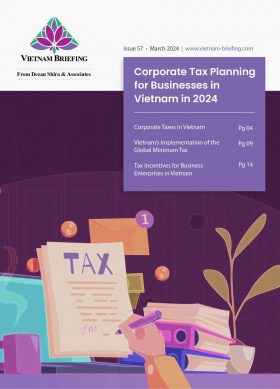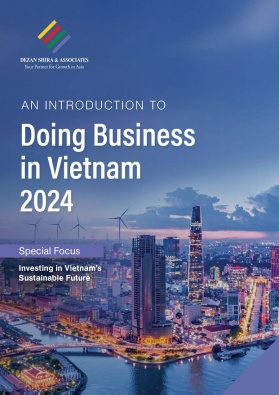Vietnam Adopts Hydrogen Energy Strategy to Boost Energy Transition
In a new strategy, Vietnam has laid out a range of development targets for the hydrogen industry for the period to 2030 and with a vision to 2050, which will support the country’s sustainability, power capacity expansion, and decarbonization goals. The Hydrogen Energy Strategy came into effect on February 7, 2024, and will be of interest to international investors and R&D and technology stakeholders in the energy domain.
Vietnam has adopted a decision on a new strategy to develop its hydrogen energy capacity and utilization, forming part of a broader effort to transform the country’s energy market and reach its sustainability goals. Decision No: 165/Qd-Ttg on the Approval of Vietnam’s Hydrogen Energy Development Strategy to 2030 and Vision to 2050 (the “Hydrogen Energy Strategy”) sets out a range of development targets for the hydrogen industry.
The Hydrogen Energy Strategy was developed based on the National Energy Development Master Plan, which lays out the foundation for the Vietnamese energy sector, including oil and gas, coal, electricity, and renewable energy, for the period from 2021 to 2030, with a vision to 2050.
The Hydrogen Energy Strategy came into effect on the day it was adopted on February 7, 2024.
Objectives of the Hydrogen Energy Strategy
The overarching goal of the Hydrogen Energy Strategy is to develop the various stages of Vietnam’s hydrogen energy ecosystem, including production, storage, transportation, distribution, domestic use, and export. This development aims to help ensure energy security, achieve national goals on climate change and green growth, and achieve Vietnam’s 2050 net-zero emissions target.
Major goals include transitioning traditional power plants to use hydrogen energy, applying carbon capture technologies, increasing hydrogen production capacity, and repurposing existing infrastructure for the hydrogen energy market supply chain.
The strategy thereafter outlines a variety of more granular goals for the years 2030 and 2050.
Targets in hydrogen energy production
By 2030, the Hydrogen Energy Strategy aims to:
- Implement and apply advanced world technologies in producing green hydrogen energy in Vietnam.
- Implement and apply advanced world technologies in carbon capture and utilization/storage (CCS/CCUS) integrated with the process of producing hydrogen energy from other sources (such as coal and natural gas).
- Strive for a production capacity of hydrogen from renewable energy utilization and other processes with carbon capture to reach around 100,000 to 500,000 tons per year by 2030.
By 2050, Vietnam will aim to:
- Absorb and master advanced technologies in producing green hydrogen energy in Vietnam.
- Absorb and master advanced technologies in CCS/CCUS integrated with the process of producing hydrogen energy from other sources.
- Strive for a production capacity of hydrogen from renewable energy utilization and other processes with carbon capture to reach around 10 to 20 million tons per year by 2050.
Targets in hydrogen energy usage
By 2030, the Hydrogen Energy Strategy aims to:
- Gradually develop the hydrogen energy market in accordance with the fuel conversion roadmap in energy-using sectors of the economy, including electricity production, transportation, industrial, commercial, and civil industries.
- Deploy and apply hydrogen-derived energy testing in a number of fields with the ability to take advantage of existing infrastructure. This will include:
- Researching and piloting the co-firing of gas with hydrogen and coal with ammonia at gas and coal power plants to prepare for the implementation of the fuel conversion roadmap to hydrogen-based energy.
- Researching and piloting the implementation of hydrogen energy for public and long-distance transportation.
- Researching and piloting the implementation of green hydrogen energy to replace grey hydrogen in fertilizer production and oil refining and piloting the use of hydrogen and hydrogen-origin fuels in green steel, cement production, and other industries, while maintaining low emissions.
By 2050, Vietnam will:
- Promote the application of green hydrogen energy and hydrogen-origin fuels in all energy-consuming sectors to decarbonize the economy and significantly contribute to achieving the net-zero emissions goal by 2050, including by:
- Transitioning gas-fired and LNG-fired power plants to use hydrogen and coal-fired power plants to use ammonia according to the National Power Development Plan.
- Transition to using hydrogen energy in fertilizer production, oil refining, steel, and cement production to decarbonize industrial sectors.
- Transition to using hydrogen energy and hydrogen-origin fuels for vehicles in line with the green transportation industry transition.
- Develop and grow the hydrogen-origin energy consumption market through market mechanisms and healthy competition with other forms of energy.
- Target for the share of hydrogen energy and hydrogen-origin fuels to reach about 10 percent of the final energy consumption demand.
Targets for hydrogen energy storage, transportation, and distribution
By 2030, Vietnam will aim to:
- Research and pilot the use of existing infrastructure in the energy sector to serve the storage, transportation, and distribution of hydrogen energy suitable for system safety and reasonable costs.
- Research and establish pilot centers/specialized equipment production facilities to serve hydrogen energy transportation, storage, and distribution.
- Research and establish pilot systems for hydrogen energy distribution in the transportation sector on routes and areas with favorable conditions.
By the year 2050, Vietnam aims to:
- Develop and improve the infrastructure system for storing, distributing, and using hydrogen with a market scale of about 10 to 20 million tons per year.
- Expand and enhance hydrogen distribution systems for the transportation sector nationwide in line with the global trend.
Targets for hydrogen energy export
By 2030, Vietnam aims to leverage natural resources of renewable energy (such as wind and solar) and geographical advantages to encourage investment in producing green hydrogen energy for export, ensuring energy security, national defense, and economic efficiency.
Finally, by the year 2050, Vietnam will seek to formulate a comprehensive industrial energy ecosystem based on renewable, new, and green hydrogen energy, aiming to become a regional hub for the clean energy industry and the export of renewable and green hydrogen energy.
Policy and implementation
The Hydrogen Energy Strategy outlines a variety of mechanisms and policies to achieve the stated goals. These include establishing and improving the legal framework for developing the market, outlining transition mechanisms, and implementing investment regulations and preferential policies. National standards and regulations in the hydrogen energy sector will also be reviewed and amended to align with international regulations and standards.
Policies and mechanisms
Concerning specific policies and mechanisms, the Hydrogen Energy Strategy calls for establishing and supplementing regulations on renewable energy development, including hydrogen energy, in the amended Electricity Law to create a solid legal foundation and transparency for market development, and facilitate the sustainable development of new and renewable energy.
It also calls for creating mechanisms and legal frameworks for fossil fuel-based energy production and consumption enterprises to actively transition to hydrogen energy production and usage and issuing regulations on investment approval for offshore wind power projects and projects for the production and export of hydrogen/ammonia using renewable energy sources.
Preferential policies in the form of taxes, fees, and land policies will also be issued to attract investment in the development of hydrogen energy sectors.
Investment and finance
Initial investments will focus on small-scale pilot projects for clean hydrogen energy production, followed by larger-scale projects in regions with renewable energy potential. Various sources of capital will be mobilized, including domestic and international sources, to ensure competitiveness in the energy market. Green financing and climate financing will be utilized, along with negotiations for funding support from international partners.
Science and technology
Continuous updates on global advancements in energy-related technologies will be integrated. Research, technology transfer, and application in hydrogen energy production will be prioritized, incentivizing domestic energy companies to invest in research and development.
Training and human resource development
The strategy calls for developing plans for training and developing human resources in key technology areas of the hydrogen energy sector. In addition, Vietnam will seek to strengthen collaboration with domestic and international training institutions, focusing on vocational training for skilled workers proficient in modern technologies.
Environmental protection and sustainable development
The strategy states that Vietnam will seek to achieve energy transition from fossil fuels to hydrogen-origin energy to reduce air pollution and greenhouse gas emissions, achieve the net-zero emissions goal by 2050, protect the environment, and promote sustainable development.
To achieve this, Vietnam will promote the application of new and modern scientific and technological achievements to facilitate a swift and strong transition to a low-carbon and circular economy, reduce energy consumption and emissions, and meet carbon emission regulations on exported goods and the carbon market.
It will also implement the construction of hydrogen-origin energy projects and infrastructure in compliance with environmental protection laws, and biodiversity regulations, ensuring safe and stable operation, and minimizing risks, losses, and damages caused by climate change.
International cooperation
Vietnam will seek to strengthen international collaboration in research, technology development, and hydrogen energy utilization. It will also seek to form strategic partnerships to achieve production, usage, export, and import goals. International commitments and support will be maximized for technology transfer, governance, human resource development, and financial supply.
Communication activities
Vietnam will seek to raise public awareness of the benefits of clean energy, specifically hydrogen, through communication activities. Collaboration with state agencies, organizations, and individuals will facilitate dissemination and education programs on the hydrogen economy and clean energy policies throughout society.
About Us
Vietnam Briefing is published by Asia Briefing, a subsidiary of Dezan Shira & Associates. We produce material for foreign investors throughout Asia, including ASEAN, China, and India. For editorial matters, contact us here and for a complimentary subscription to our products, please click here. For assistance with investments into Vietnam, please contact us at vietnam@dezshira.com or visit us at www.dezshira.com.
Dezan Shira & Associates assists foreign investors throughout Asia from offices across the world, including in Hanoi, Ho Chi Minh City, and Da Nang. We also maintain offices or have alliance partners assisting foreign investors in China, Hong Kong SAR, Dubai (UAE), Indonesia, Singapore, Philippines, Malaysia, Thailand, Bangladesh, Italy, Germany, the United States, and Australia.
- Previous Article Why Cambodia’s Funan Techo Canal Project is Worrying Vietnam
- Next Article Vietnam Decree 23 Outlines Bidding Processes for Key Sectors Projects








